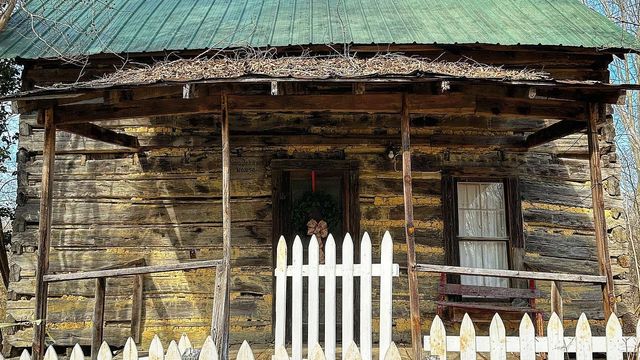Secrets of rural NC: This old country road will take you to a lost stop on the Underground Railroad
Driving along the back roads of Alamance County, you’ll find the crumbling remnants of a colonial settlement -- older than the United States itself.
Park your car and step into the 1700s: Small wooden houses, a historic post office, and even an old school house – still full of antique desks and a tattered map. One tiny wooden building squats behind a historic marker describing it as an original Quaker meeting house.
It was in this small, unassuming and un-incorporated community of Snow Camp that Freedom Seekers would hide as they escaped from slavery down the Underground Railroad.

A map to freedom: Underground Railroad 'stations' dotted central NC
In this part of North Carolina, 'stations' along the Underground Railroad could be found every 20 miles or so – about as far as a Freedom Seeker could travel in one night. The high population of Friends – colloquially known as Quakers – and communities of free Black families provided safe houses for freedom seekers moving north. Quakers were known by many during the era as passionate abolitionists, who would often provide food, shelter and supplies for Freedom Seekers along the Underground Railroad.
"We are the Quaker Belt of North Carolina," says Ron Osborne, a historian and member of one of the oldest Friends meetings in the area, the Spring Friend Meeting.
Even today, there are Friends living in Snow Camp whose history connects back to the Underground Railroad.
Osborne can trace his roots back to his great-great-great grandfather Needham Perkins, who ran a 'station' on his farm.

"So this area of Snow Camp may have been a station, and the next station would have been up around New Garden. Centre may have been a station, and Mendenhall Plantation," he says.
Even today, Mendenhall has one of the only remaining relics of the Underground Railroad in NC: A false-bottom wagon used to 'smuggle' Freedom Seekers to safety.
This dangerous, unwritten pathway to freedom was not documented. To help protect Freedom Seekers and abolitionists alike, secret codes and hushed voices provided the only guidance along this portion of the Underground Railroad.
"There was this very loose organization of stations, and probably the next station up the road knew who you were, but you didn’t know who the subsequent stations were -- so that if somebody got caught, the whole system was not compromised," says Osborne.
His great-great-great grandfather Needham Perkins was, in his younger years, a teacher at the New Garden Boarding School – today known as Guilford College. A tree known as the 'Underground Railroad Tree' still stands on that campus today, a centuries-old marker of the old-growth forest where Freedom Seekers would hide along the pathway to freedom. Students of the school were known to bring supplies and food to Freedom Seekers hiding in the woods around that tree.

Dangers of the Underground Railroad
Whether you were a Freedom Seeker trying to escape or an abolitionist trying to help, there was immense risk to taking part in Underground Railroad activities. This necessitated extreme secrecy – leaving very little oral or written history for us to find today.
Needham Perkins was eventually 'punished' by his neighbors, who discovered he'd been helping the abolitionist cause. His experience provides a real-life example of the real dangers abolitionists could face.
"He was returning home one evening from an extended trip, and two of his neighbors fell upon him in the dark," explains Osborne. "They were waiting for him on his way home, knowing he was going to be there. They used the stock of the rifle to beat him. They slashed his throat. They knocked all of his teeth out. And left him for dead.”

Perkins did survive the experience, according to Osborne. However, Freedom Seekers caught escaping faced the threat of torture – and, of course, losing their freedom. An 1800s jail still standing in Halifax County provides proof of that history.
Despite facing potential for torture, there is documentation that many Freedom Seekers tried multiple times for their freedom – showing the strength of their enduring desire and dream of living free.
Rivers, known as Freedom Roads, were often a powerful symbol in the Underground Railroad. Even today, some popular hymns, such as Deep River, tell the tale of crossing rivers and finding freedom. Some historians say these hymns served as a 'map' for Freedom Seekers, guiding them on which rivers to follow and which settlements would have 'Friends' to help them along the way.
For Freedom Seekers in this part of North Carolina, the symbol of freedom was the Ohio River. After many nights of traveling and hiding at stations along the Underground Railroad, they'd see the river and cross into the 'Free State' of Ohio.

What can you see today?
Today, the centuries-old community of Snow Camp still holds many remnants of Underground Railroad history. At the Snow Camp Outdoor Theater, there are old, wooden structures dating back to the 1800s and before.

A tiny, crumbling wooden structure is marked as one of the first Friends meeting houses. Peek in the window of a historic post office, where everything is frozen in time.
There's even an old school where emancipated children were educated after the Civil War – the old desks, chalkboards and a tattered map still decorate the room.

Just down the road, an old stone wall marks one of the oldest homesteads in the area. Frozen in time, the historic meeting houses for the Spring Friends Meeting and Cane Creek Friends Meeting strike an idyllic pose on the antiquated landscape.
Snow Camp is rural enough that history has been preserved – allowing visitors to touch tangible remnants of the Underground Railroad firsthand.
Listen to stories about secret codes used by the Underground Railroad
To maintain secrecy, the Underground Railroad used everything from songs to scattered black-eyed peas to share secret codes. Something as simple as the color of a thread on your skirt could be a virtual map showing Freedom Seekers whether they should escape by water or stay hiding in the woods. Hear WRAL's Amanda Lamb talk to Hidden Historian Heather Leah about more secrets of the Underground Railroad in our podcast.
Visit these real-life places in NC connected to the Underground Railroad
In our Following the Underground Railroad series, we show you multiple places across the state you can visit to touch tangible remnants of the Underground Railroad.
This enormous swamp holds centuries-old secrets from the Underground Railroad -- including remnants of Maroon Colonies formed by Freedom Seekers who chose to live in the swamp.
Halifax was a site of triumph for many Freedom Seekers, who escaped across the Roanoke River. However, it's also home to a jail where Freedom Seekers were imprisoned if they were caught.
Take a look at one of the last remaining relics from the Underground Railroad in NC: A genuine false-bottom wagon where enslaved Freedom Seekers once hid while trying to escape north.
Or visit a 200-year-old aqueduct, built using enslaved labor, that ended up helping enslaved men and women escape instead.
Explore this patch of old-growth woods, undeveloped since the 1800s, where the Underground Railroad Tree stands as a reminder of Freedom Seekers who once hid in these woods, helped by nearby Quakers.
Learn about the secret codes used by abolitionists to help pass messages safely in the Underground Railroad.

















